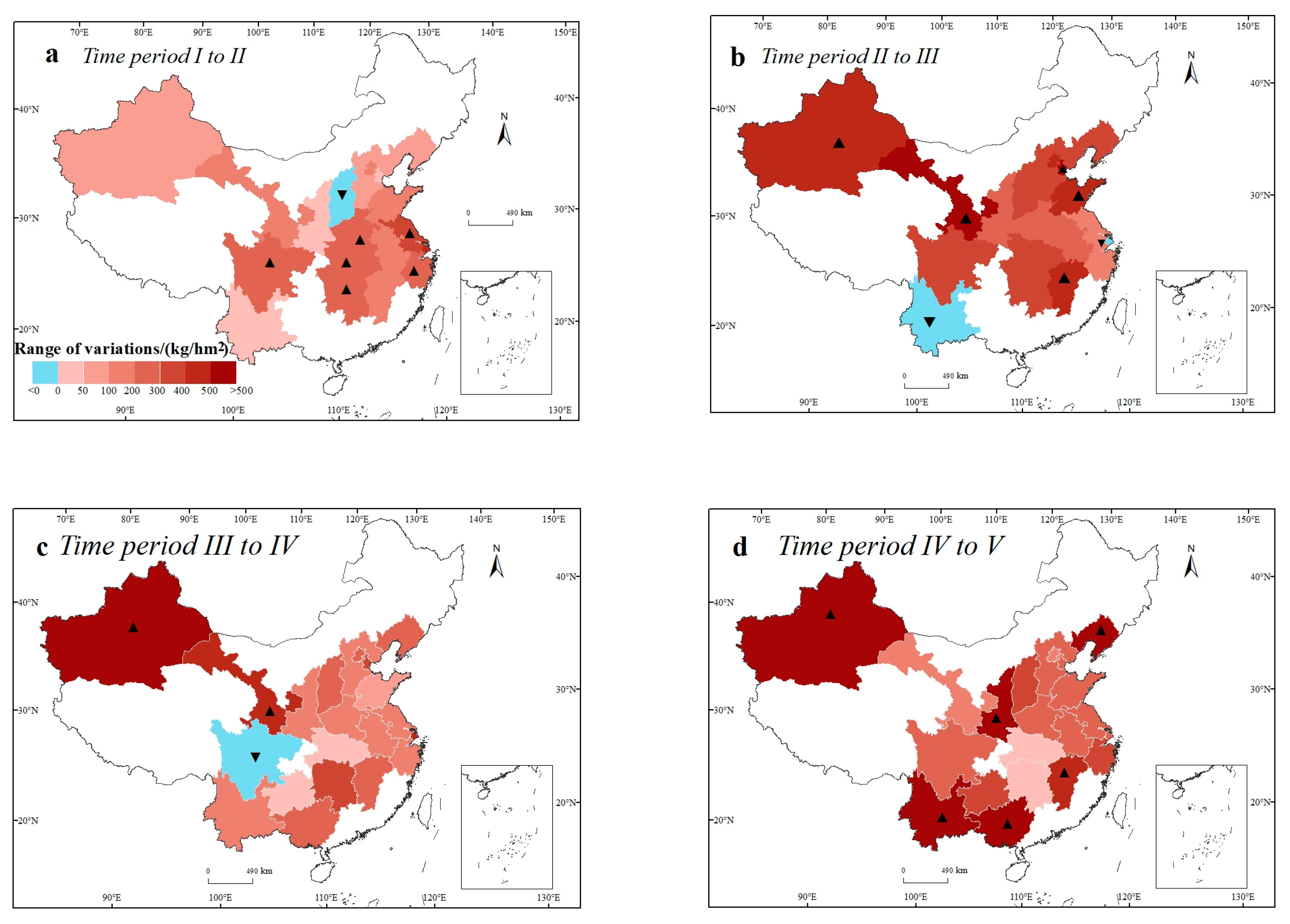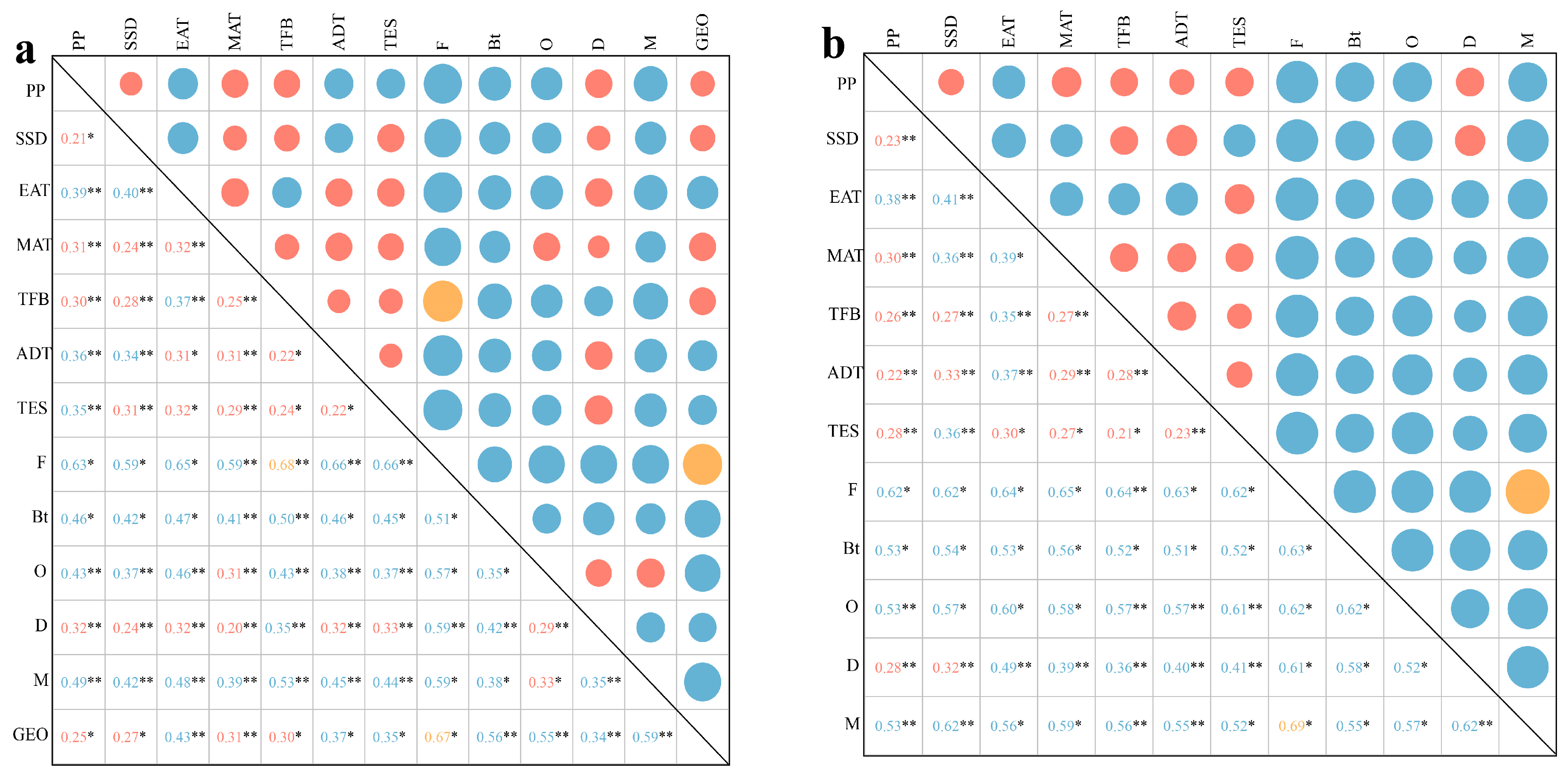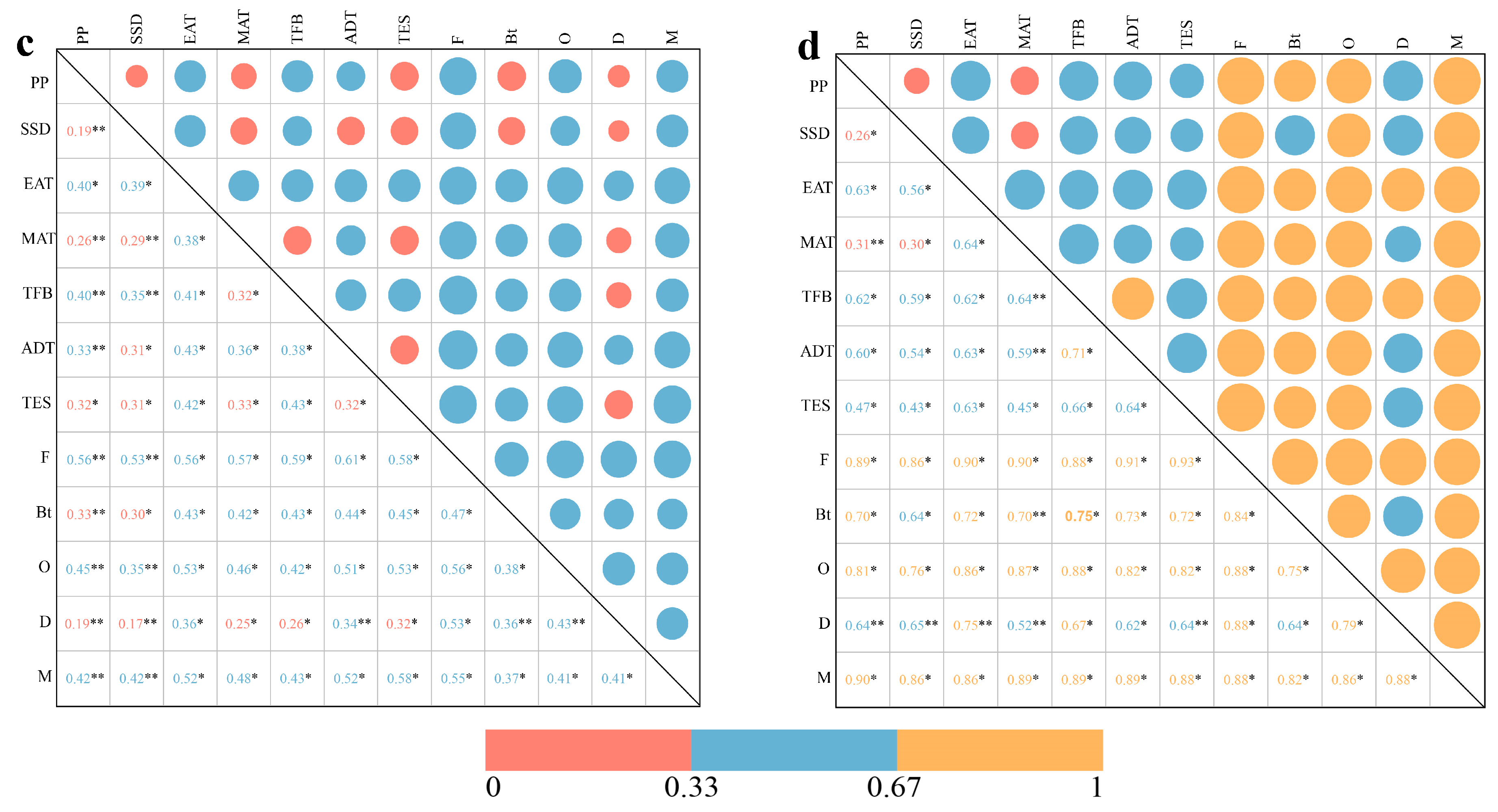Uncovering the Drivers and Regional Variability of Cotton Yield in China
Abstract
:1. Introduction
2. Materials and Methods
2.1. Research Data and Region
2.2. Conceptual Framework: Determinants of Cotton Yield
2.3. Methods
2.3.1. Climate Factor Calculations by Cotton Phenology
2.3.2. Pettitt Mutation Test
2.3.3. Geographical Detector Model
2.3.4. Factor Detector
2.3.5. Interaction Detector
3. Results
3.1. Inter-Annual Variation of Cotton Cultivation
3.2. Cotton Yield Variation
3.3. Analysis of Factors That Influence Cotton Yield in Different Regions
3.3.1. Factor Detection Analysis
3.3.2. Interaction Detection Analysis
4. Discussion
4.1. Impacts of Climate Change on Crop Yield
4.2. Impact of Agricultural Technology on Spatial Pattern of Crop Cultivation
4.3. Limitations of the Study and Future Prospects
5. Conclusions
Supplementary Materials
Author Contributions
Funding
Data Availability Statement
Conflicts of Interest
References
- Zhai, X.; Yuan, R. Changes in the pattern of the global cotton industry in the last 30 years and its impact on the Chinese cotton industry. World Agric. 2019, 08, 71–78, 127–128. [Google Scholar] [CrossRef]
- Han, X. What Do you Know about the Global Cotton Trade? ATPC Agricultural Trade Promotion Center, Ministry of Agriculture and Rural Affairs. 2022. Available online: http://www.mczx.agri.cn/mybw/202203/t20220328_7832959.htm (accessed on 2 December 2022).
- Feng, L.; Chi, B.; Dong, H. Cotton Cultivation Technology with Chinese Characteristics Has Driven the 70-Year Development of Cotton Production in China. J. Integr. Agric. 2022, 21, 597–609. [Google Scholar] [CrossRef]
- Jia, H. Chinese Green Light for GM Rice and Maize Prompts Outcry. Nat. Biotechnol. 2010, 28, 390–391. [Google Scholar] [CrossRef] [PubMed]
- Han, F.; Zhou, D.; Liu, X.; Cheng, J.; Zhang, Q.; Shelton, A.M. Attitudes in China about Crops and Foods Developed by Biotechnology. PLoS ONE 2015, 10, e0139114. [Google Scholar] [CrossRef] [PubMed]
- Azadi, H.; Taheri, F.; Ghazali, S.; Movahhed Moghaddam, S.; Siamian, N.; Goli, I.; Choobchian, S.; Pour, M.; Özgüven, A.I.; Janečková, K.; et al. Genetically Modified Crops in Developing Countries: Savior or Traitor? J. Clean. Prod. 2022, 371, 133296. [Google Scholar] [CrossRef]
- Carzoli, A.K.; Aboobucker, S.I.; Sandall, L.L.; Lübberstedt, T.T.; Suza, W.P. Risks and Opportunities of GM Crops: Bt Maize Example. Glob. Food Secur. 2018, 19, 84–91. [Google Scholar] [CrossRef]
- Zuo, L.; Zhang, Z.; Carlson, K.M.; MacDonald, G.K.; Brauman, K.A.; Liu, Y.; Zhang, W.; Zhang, H.; Wu, W.; Zhao, X.; et al. Progress towards Sustainable Intensification in China Challenged by Land-Use Change. Nat. Sustain. 2018, 1, 304–313. [Google Scholar] [CrossRef]
- Aznar-Sánchez, J.A.; Piquer-Rodríguez, M.; Velasco-Muñoz, J.F.; Manzano-Agugliaro, F. Worldwide Research Trends on Sustainable Land Use in Agriculture. Land Use Policy 2019, 87, 104069. [Google Scholar] [CrossRef]
- Outhwaite, C.L.; McCann, P.; Newbold, T. Agriculture and Climate Change Are Reshaping Insect Biodiversity Worldwide. Nature 2022, 605, 97–102. [Google Scholar] [CrossRef]
- Su, Y.; Gabrielle, B.; Makowski, D. The Impact of Climate Change on the Productivity of Conservation Agriculture. Nat. Clim. Chang. 2021, 11, 628–633. [Google Scholar] [CrossRef]
- Nascimento, C.M.; de Sousa Mendes, W.; Quiñonez Silvero, N.E.; Poppiel, R.R.; Sayão, V.M.; Dotto, A.C.; Valadares dos Santos, N.; Accorsi Amorim, M.T.; Demattê, J.A.M. Soil Degradation Index Developed by Multitemporal Remote Sensing Images, Climate Variables, Terrain and Soil Atributes. J. Environ. Manag. 2021, 277, 111316. [Google Scholar] [CrossRef] [PubMed]
- Dalin, C.; Wada, Y.; Kastner, T.; Puma, M.J. Groundwater Depletion Embedded in International Food Trade. Nature 2017, 543, 700–704. [Google Scholar] [CrossRef] [PubMed]
- Li, Z.; Wan, S.; Chen, G.; Han, Y.; Lei, Y.; Ma, Y.; Xiong, S.; Mao, T.; Feng, L.; Wang, G.; et al. Effects of Irrigation Regime on Soil Hydrothermal Microenvironment, Cotton Biomass, and Yield under Non-Film Drip Irrigation System in Cotton Fields in Southern Xinjiang, China. Ind. Crops Prod. 2023, 198, 116738. [Google Scholar] [CrossRef]
- Adamopoulos, T.; Restuccia, D. Geography and Agricultural Productivity: Cross-Country Evidence from Micro Plot-Level Data. Rev. Econ. Stud. 2022, 89, 1629–1653. [Google Scholar] [CrossRef]
- Mai, J.; Liu, G. Modeling and Predicting the Effects of Climate Change on Cotton-Suitable Habitats in the Central Asian Arid Zone. Ind. Crops Prod. 2023, 191, 115838. [Google Scholar] [CrossRef]
- Zabel, F.; Delzeit, R.; Schneider, J.M.; Seppelt, R.; Mauser, W.; Václavík, T. Global Impacts of Future Cropland Expansion and Intensification on Agricultural Markets and Biodiversity. Nat. Commun. 2019, 10, 2844. [Google Scholar] [CrossRef]
- Li, N.; Li, Y.; Biswas, A.; Wang, J.; Dong, H.; Chen, J.; Liu, C.; Fan, X. Impact of Climate Change and Crop Management on Cotton Phenology Based on Statistical Analysis in the Main-Cotton-Planting Areas of China. J. Clean. Prod. 2021, 298, 126750. [Google Scholar] [CrossRef]
- Umer Arshad, M.; Yunfeng, Z.; Hanif, S.; Fatima, F. Impact of Climate Change and Technological Advancement on Cotton Production: Evidence from Xinjiang Region, China. J. Agric. Sci. Technol. 2022, 24, 1519–1531. [Google Scholar] [CrossRef]
- Zhang, T.; Zhai, Y.; Ma, X.; Shen, X.; Bai, Y.; Zhang, R.; Ji, C.; Hong, J. Towards Environmental Sustainability: Life Cycle Assessment-Based Water Footprint Analysis on China’s Cotton Production. J. Clean. Prod. 2021, 313, 127925. [Google Scholar] [CrossRef]
- Wang, Y.; Peng, S.; Huang, J.; Zhang, Y.; Feng, L.; Zhao, W.; Qi, H.; Zhou, G.; Deng, N. Prospects for Cotton Self-Sufficiency in China by Closing Yield Gaps. Eur. J. Agron. 2022, 133, 126437. [Google Scholar] [CrossRef]
- Mao, S.C. Cotton Farming in China; Shanghai Scientific and Technical Press: Shanghai, China, 2019. [Google Scholar]
- Miao, R.; Khanna, M.; Huang, H. Responsiveness of Crop Yield and Acreage to Prices and Climate. Am. J. Agric. Econ. 2016, 98, 191–211. [Google Scholar] [CrossRef]
- Lombardo, U.; Iriarte, J.; Hilbert, L.; Ruiz-Pérez, J.; Capriles, J.M.; Veit, H. Early Holocene Crop Cultivation and Landscape Modification in Amazonia. Nature 2020, 581, 190–193. [Google Scholar] [CrossRef] [PubMed]
- Chen, C.; Pang, Y.; Pan, X.; Zhang, L. Impacts of Climate Change on Cotton Yield in China from 1961 to 2010 Based on Provincial Data. J. Meteorol. Res. 2015, 29, 515–524. [Google Scholar] [CrossRef]
- Reddy, K.R.; Brand, D.; Wijewardana, C.; Gao, W. Temperature Effects on Cotton Seedling Emergence, Growth, and Development. Agron. J. 2017, 109, 1379–1387. [Google Scholar] [CrossRef]
- Shi, X.; Wang, C.; Zhao, J.; Wang, K.; Chen, F.; Chu, Q. Increasing Inconsistency between Climate Suitability and Production of Cotton (Gossypium hirsutum L.) in China. Ind. Crops Prod. 2021, 171, 113959. [Google Scholar] [CrossRef]
- Li, N.; Yao, N.; Li, Y.; Chen, J.; Liu, D.; Biswas, A.; Li, L.; Wang, T.; Chen, X. A Meta-Analysis of the Possible Impact of Climate Change on Global Cotton Yield Based on Crop Simulation Approaches. Agric. Syst. 2021, 193, 103221. [Google Scholar] [CrossRef]
- Celik, M.F.; Isik, M.S.; Taskin, G.; Erten, E.; Camps-Valls, G. Explainable Artificial Intelligence for Cotton Yield Prediction with Multisource Data. IEEE Geosci. Remote Sens. Lett. 2023, 20, 1–5. [Google Scholar] [CrossRef]
- Witjaksono, J.; Wei, X.; Mao, S.; Gong, W.; Li, Y.; Yuan, Y. Yield and Economic Performance of the Use of GM Cotton Worldwide over Time: A Review and Meta-Analysis. China Agric. Econ. Rev. 2014, 6, 616–643. [Google Scholar] [CrossRef]
- Sun, Y.; Fan, W.Y.; Shi, P.J.; Wang, C.J.; Sun, S. Regional differences in the effects of climate and management factor changes on cotton yields in Hubei. Geogr. Stud. 2021, 40, 1064–1077. [Google Scholar]
- Zhai, X.L.; Dai, P. Factor inputs, technological progress and cotton output growth: An empirical study based on Bayesian panel stochastic frontier model. Agric. Technol. Econ. 2021, 01, 129–144. [Google Scholar] [CrossRef]
- Tan, X.Y.; Zhang, X.H.; You, L.Z. Impact of natural factors and policy intervention on the changing layout of cotton production in China. Agric. Technol. Econ. 2020, 04, 79–93. [Google Scholar] [CrossRef]
- Shawul, A.A.; Chakma, S. Trend of Extreme Precipitation Indices and Analysis of Long-Term Climate Variability in the Upper Awash Basin, Ethiopia. Theor. Appl. Clim. 2020, 140, 635–652. [Google Scholar] [CrossRef]
- R Core Team. R: A Language and Environment for Statistical Computing; R Foundation for Statistical Computing: Vienna, Austria, 2021; Available online: https://www.R-project.org/ (accessed on 10 February 2015).
- Gollini, I.; Lu, B.; Charlton, M.; Brunsdon, C.; Harris, P. GWmodel: An R Package for Exploring Spatial Heterogeneity Using Geographically Weighted Models. J. Stat. Softw. 2015, 63, 1–50. [Google Scholar] [CrossRef]
- Wang, J.-F.; Hu, Y. Environmental Health Risk Detection with GeogDetector. Environ. Model. Softw. 2012, 33, 114–115. [Google Scholar] [CrossRef]
- Wu, Q.; Hu, W.; Wang, H.; Liu, P.; Wang, X.; Huang, B. Spatial Distribution, Ecological Risk and Sources of Heavy Metals in Soils from a Typical Economic Development Area, Southeastern China. Sci. Total Environ. 2021, 780, 146557. [Google Scholar] [CrossRef]
- Calzadilla, A.; Rehdanz, K.; Betts, R.; Falloon, P.; Wiltshire, A.; Tol, R.S.J. Climate Change Impacts on Global Agriculture. Clim. Chang. 2013, 120, 357–374. [Google Scholar] [CrossRef]
- Fan, L.; Liang, S.; Chen, H.; Hu, Y.; Zhang, X.; Liu, Z.; Wu, W.; Yang, P. Spatio-Temporal Analysis of the Geographical Centroids for Three Major Crops in China from 1949 to 2014. J. Geogr. Sci. 2018, 28, 1672–1684. [Google Scholar] [CrossRef]
- Song, G.; Ren, G. Spatial Response of Cultivated Land Use Efficiency to the Maize Structural Adjustment Policy in the “Sickle Bend” Region of China: An Empirical Study from the Cold Area of Northeast. Land Use Policy 2022, 123, 106421. [Google Scholar] [CrossRef]
- Han, W.; Liu, S.; Wang, J.; Lei, Y.; Zhang, Y.; Han, Y.; Wang, G.; Feng, L.; Li, X.; Li, Y.; et al. Climate Variation Explains More than Half of Cotton Yield Variability in China. Ind. Crops Prod. 2022, 190, 115905. [Google Scholar] [CrossRef]
- Han, W.; Lin, X.; Wang, D. Uncovering the Primary Drivers of Regional Variability in the Impact of Climate Change on Wheat Yields in China. J. Clean. Prod. 2023, 421, 138479. [Google Scholar] [CrossRef]
- Wu, X.; Wang, Z.; Guo, L.; Liu, J.; Dhital, Y.P.; Zhu, Y.; Song, L.; Wen, Y. Timing and Water Temperature of Drip Irrigation Regulate Cotton Growth and Yield under Film Mulching in Arid Areas of Xinjiang. J. Sci. Food Agric. 2023, 103, 5754–5769. [Google Scholar] [CrossRef]
- Feng, J.; Liu, H.; Wang, G.; Tian, R.; Cao, M.; Bai, Z.; He, T. Effect of Periodic Winter Irrigation on Salt Distribution Characteristics and Cotton Yield in Drip Irrigation under Plastic Film in Xinjiang. Water 2021, 13, 2545. [Google Scholar] [CrossRef]
- Wu, H.; Guo, S.; Guo, P.; Shan, B.; Zhang, Y. Agricultural Water and Land Resources Allocation Considering Carbon Sink/Source and Water Scarcity/Degradation Footprint. Sci. Total Environ. 2022, 819, 152058. [Google Scholar] [CrossRef] [PubMed]
- Hu, Y.; Ma, P.; Wu, S.; Sun, B.; Feng, H.; Pan, X.; Zhang, B.; Chen, G.; Duan, C.; Lei, Q.; et al. Spatial-Temporal Distribution of Winter Wheat (Triticum aestivum L.) Roots and Water Use Efficiency under Ridge–Furrow Dual Mulching. Agric. Water Manag. 2020, 240, 106301. [Google Scholar] [CrossRef]
- Yang, S.; Wang, H.; Tong, J.; Bai, Y.; Alatalo, J.M.; Liu, G.; Fang, Z.; Zhang, F. Impacts of Environment and Human Activity on Grid-Scale Land Cropping Suitability and Optimization of Planting Structure, Measured Based on the MaxEnt Model. Sci. Total Environ. 2022, 836, 155356. [Google Scholar] [CrossRef] [PubMed]
- Wu, Y.L. Technological progress and the rise of the “cotton kingdom” in the United States. Nat. Dialectics Lett. 2019, 41, 52–59. [Google Scholar] [CrossRef]
- Rocha-Munive, M.G.; Soberón, M.; Castañeda, S.; Niaves, E.; Scheinvar, E.; Eguiarte, L.E.; Mota-Sánchez, D.; Rosales-Robles, E.; Nava-Camberos, U.; Martínez-Carrillo, J.L.; et al. Evaluation of the Impact of Genetically Modified Cotton after 20 Years of Cultivation in Mexico. Front. Bioeng. Biotechnol. 2018, 6, 82. [Google Scholar] [CrossRef]
- Dong, H.-Z.; Yang, G.-Z.; Li, Y.-B.; Tian, L.-W.; Dai, J.-L.; Kong, X.-Q. Key Technologies for Light and Simplified Cultivation of Cotton and Their Eco-Physiological Mechanisms. Acta Agron. Sin. 2017, 43, 631–639. [Google Scholar] [CrossRef]
- Dai, J.; Kong, X.; Zhang, D.; Li, W.; Dong, H. Technologies and Theoretical Basis of Light and Simplified Cotton Cultivation in China. Field Crops Res. 2017, 214, 142–148. [Google Scholar] [CrossRef]





| Type | Variables | Codes | Meaning and Assignment of Variables |
|---|---|---|---|
| Dependent variables | Cotton yield | — | Total cotton production/the area of cotton cultivation (kg/hm2) |
| Spatial indicators | Geographic region | GEO | The cotton-growing geographic regions in which the province is located (categorical variables) |
| Climatic indicators | Average daily temperature from Sow to Squ | ADT | Average of the daily temperature from Sow to Squ in the growth period (°C) |
| Precipitation | PP | Sum of the daily precipitation from Squ to Bol in the growth period (mm) | |
| Solar radiation | SSD | Sum of the daily sunshine duration from Sow to Mat in the growth period (hours) | |
| Effective accumulated temperature | EAT | Sum of the daily temperature between 12 °C and 36 °C from Sow to Mat in the growth period (°C·d) | |
| Minimum temperature from Eme to Squ | TES | Average of the minimum daily temperature from Eme to Squ in the growth period (°C) | |
| Minimum temperature from Flo to Bol | TFB | Average of the minimum daily temperature from Flo to Bol in the growth period (°C) | |
| Maximum temperature from Flo to Bol | MAT | Average of the maximum daily temperature from Flo to Bol in the growth period (°C) | |
| Disaster indicators | Disaster area | D | Natural disasters such as drought and floods have reduced cotton production by more than 10% (hm2) |
| Technical indicators | Chemical fertilizer use | F | Cost of chemical fertilizer per mu (mu yuan−1) * |
| Total power of agricultural machinery | M | Total power of agricultural machinery/crop sown area (kWh hm−2) | |
| Bt transgenic insect-resistant cotton | Bt | The year of first approval of the biosafety certificate for Bt transgenic insect-resistant cotton in the region; Bt = 1, otherwise, Bt = 0 | |
| Social indicators | Non-farm employment opportunities | O | Value-added by secondary and tertiary industry/gross regional product (%) |
| Factor | China | Yellow River Basin | Yangtze River Basin | Northwest Inland | ||||
|---|---|---|---|---|---|---|---|---|
| q Value | Sig. | q Value | Sig. | q Value | Sig. | q Value | Sig. | |
| EAT | 0.196 | <0.001 | 0.238 | <0.001 | 0.344 | <0.001 | 0.536 | <0.001 |
| PP | 0.168 | <0.001 | 0.069 | 0.182 | 0.062 | 0.013 | 0.148 | 0.015 |
| SSD | 0.114 | <0.001 | 0.114 | 0.010 | 0.062 | 0.107 | 0.193 | 0.019 |
| ADT | 0.143 | <0.001 | 0.100 | 0.003 | 0.269 | <0.001 | 0.460 | <0.001 |
| TES | 0.158 | <0.001 | 0.144 | 0.000 | 0.288 | <0.001 | 0.421 | <0.001 |
| TFB | 0.098 | <0.001 | 0.078 | 0.009 | 0.212 | <0.001 | 0.496 | <0.001 |
| MAT | 0.069 | <0.001 | 0.158 | <0.001 | 0.188 | <0.001 | 0.103 | 0.003 |
| D | 0.080 | <0.001 | 0.153 | <0.001 | 0.073 | 0.017 | 0.269 | 0.073 |
| O | 0.190 | <0.001 | 0.459 | <0.001 | 0.290 | <0.001 | 0.729 | <0.001 |
| M | 0.248 | <0.001 | 0.438 | <0.001 | 0.321 | <0.001 | 0.817 | <0.001 |
| F | 0.503 | <0.001 | 0.557 | <0.001 | 0.461 | <0.001 | 0.831 | <0.001 |
| Bt | 0.322 | <0.001 | 0.492 | <0.001 | 0.266 | <0.001 | 0.590 | <0.001 |
| GEO | 0.225 | <0.001 | - | - | - | - | - | - |
Disclaimer/Publisher’s Note: The statements, opinions and data contained in all publications are solely those of the individual author(s) and contributor(s) and not of MDPI and/or the editor(s). MDPI and/or the editor(s) disclaim responsibility for any injury to people or property resulting from any ideas, methods, instructions or products referred to in the content. |
© 2023 by the authors. Licensee MDPI, Basel, Switzerland. This article is an open access article distributed under the terms and conditions of the Creative Commons Attribution (CC BY) license (https://creativecommons.org/licenses/by/4.0/).
Share and Cite
Zhu, Y.; Zheng, B.; Luo, Q.; Jiao, W.; Yang, Y. Uncovering the Drivers and Regional Variability of Cotton Yield in China. Agriculture 2023, 13, 2132. https://doi.org/10.3390/agriculture13112132
Zhu Y, Zheng B, Luo Q, Jiao W, Yang Y. Uncovering the Drivers and Regional Variability of Cotton Yield in China. Agriculture. 2023; 13(11):2132. https://doi.org/10.3390/agriculture13112132
Chicago/Turabian StyleZhu, Yaqiu, Bangyou Zheng, Qiyou Luo, Weihua Jiao, and Yadong Yang. 2023. "Uncovering the Drivers and Regional Variability of Cotton Yield in China" Agriculture 13, no. 11: 2132. https://doi.org/10.3390/agriculture13112132
APA StyleZhu, Y., Zheng, B., Luo, Q., Jiao, W., & Yang, Y. (2023). Uncovering the Drivers and Regional Variability of Cotton Yield in China. Agriculture, 13(11), 2132. https://doi.org/10.3390/agriculture13112132






